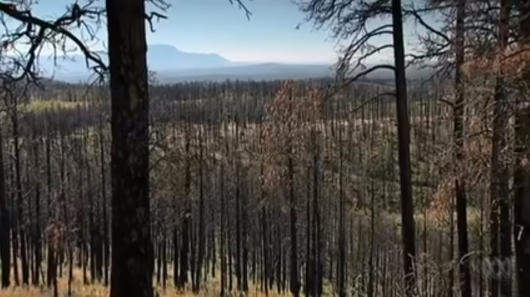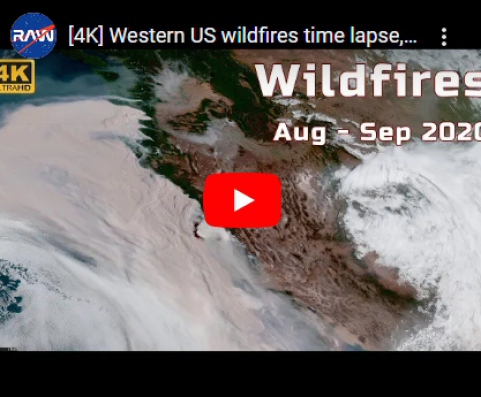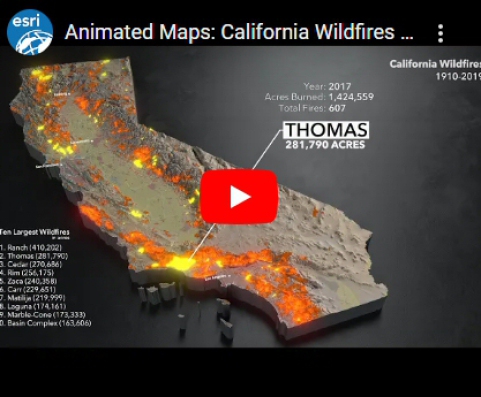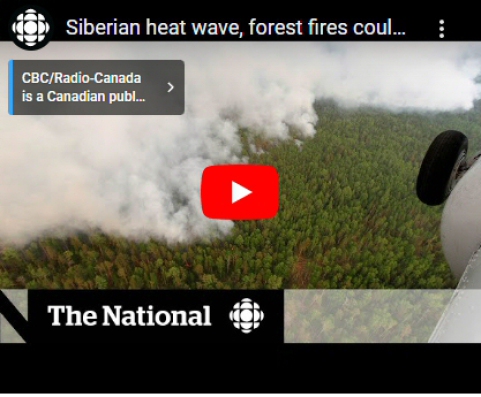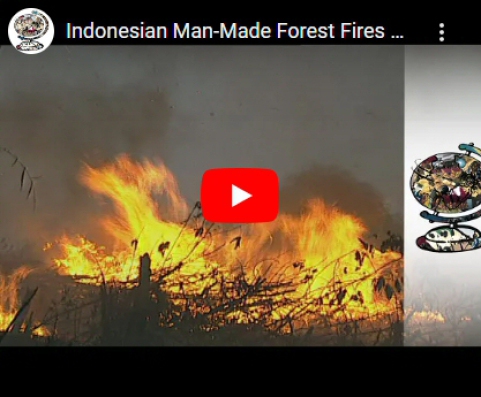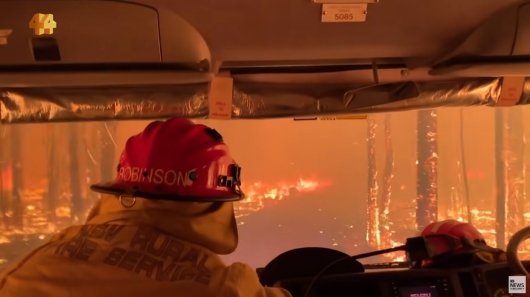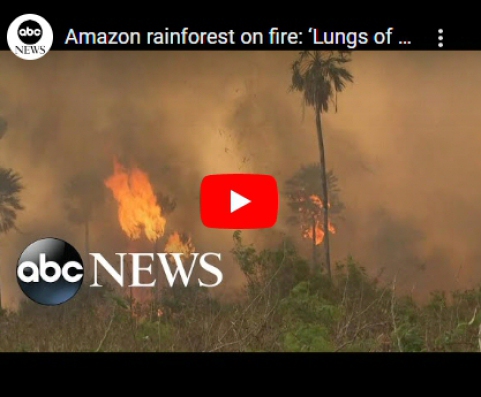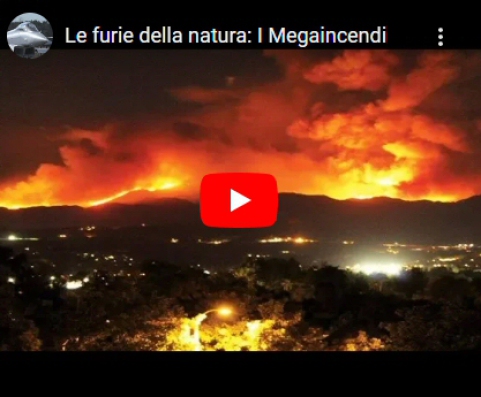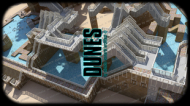MEGAFIRES
Extreme Wildfires:
How megafires are reshaping forests
Fire in Paradise
The Great Yellowstone Fire (1990)
Earth on Fire
ABC Australia
Western US wildfires time lapse, Aug 16-Sep 10
Animated Maps:
California Wildfires from 1910-2019
Special Report: Canada Wildfires
Siberian Wildfires
Indonesian Man-Made Forest Fires
The stories behind the viral videos
from Australia's bushfire crisis
Amazon Man-Made Rainforest Fires
Living in the Era of Megafires
BIBLIOGRAPHY
Don G. Despain, William H. Romme: "The Yellowstone Fires", Scientific American, November 1989.
During the summer of 1988 fires swept across much of Yellowstone National Park. Why did so many acres burn in one year? A look at the ecological history of the region provides some answers.
Kathy Furgang: "Wildfires", National Geographic Readers, 2015.
Learn all about wildfires-how they happen, why they're important, and when they're dangerous-in this fascinating level 3 reader. It's sure to ignite your interest, with color photographs, interesting facts, and more.
Mark Thiessen: "Extreme Wildfire: Smoke Jumpers, High-Tech Gear, Survival Tactics, and the Extraordinary Science of Fire", National Geographic Kids, 2016.
In one moment, there’s a simple spark, and then roaring flames surge 200 feet into the air, devouring forests. Trees, from root to canopy, are burned to the ground. Airtankers and helicopters hover above, executing an air attack. Brave firefighters, equipped with flame resistant suits, leap from helicopters onto the treetops and descend to the blazing forest floor.
In this book, young readers will learn about the ecological impacts of wildfires, the ins and outs of fire science including tactics for prevention and containment, cutting-edge technology used to track wildfires and predict fire behavior, and about the impressive skill, survival tactics, and bravery required to control a wildfire. Also included are expert tips, fun facts, and breathtaking photos taken by the author.
Stephen J. Pyne: "Fire: Nature and Culture", 2012.
For over 400 million years, fire has been an integral force on our planet. It can be as innocent as a bonfire or as destructive and lethal as a wildfire. Human history is rife with fires that have leveled cities—the Fire of Moscow in 1812 that destroyed seventy-five percent of the city, the Great Chicago Fire in 1871 that took down 17,000 buildings, and the fire that obliterated San Francisco after the 1906 earthquake are just a few. Fire is a force of nature that can consume everything in its wake, and yet it also has tremendous powers of cleansing and renewal. At the end of the day, we can’t live without it.
In Fire, Stephen J. Pyne offers a concise history of fire and its use by humanity, explaining how fire has been at the core of hunting, foraging, farming, herding, urbanizing, and managing nature reserves. He depicts how it gave humans power in ancient times, which resulted in humanity beginning to reshape the world for its own benefit. He describes how fire was used by aboriginal societies and the ways agricultural societies added control over fuel, but warns that our mastery of the science and art of fire has not given us complete control—fire disasters throughout history have defined cultures, and unexpected fires that begin as the result of other disasters have shocking effects. Pyne traces fire’s influence on landscapes, art, science, and even climate, exploring the power a simple spark has over our imaginations.
Alastair Gee and Dani Anguiano: "Fire in Paradise: An American Tragedy", 2020.
The harrowing story of the most destructive American wildfire in a century.
There is no precedent in postwar American history for the destruction of the town of Paradise, California. On November 8, 2018, the community of 27,000 people was swallowed by the ferocious Camp Fire, which razed virtually every home and killed at least 85 people. The catastrophe seared the American imagination, taking the front page of every major national newspaper and top billing on the news networks. It displaced tens of thousands of people, yielding a refugee crisis that continues to unfold.
Fire in Paradise is a dramatic and moving narrative of the disaster based on hundreds of in-depth interviews with residents, firefighters and police, and scientific experts. Alastair Gee and Dani Anguiano are California-based journalists who have reported on Paradise since the day the fire began. Together they reveal the heroics of the first responders, the miraculous escapes of those who got out of Paradise, and the horrors experienced by those who were trapped. Their accounts are intimate and unforgettable, including the local who left her home on foot as fire approached while her 82-year-old father stayed to battle it; the firefighter who drove into the heart of the inferno in his bulldozer; the police officer who switched on his body camera to record what he thought would be his final moments as the flames closed in; and the mother who, less than 12 hours after giving birth in the local hospital, thought she would die in the chaotic evacuation with her baby in her lap. Gee and Anguiano also explain the science of wildfires, write powerfully about the role of the power company PG&E in the blaze, and describe the poignant efforts to raise Paradise from the ruins.
This is the story of a town at the forefront of a devastating global shift―of a remarkable landscape sucked ever drier of moisture and becoming inhospitable even to trees, now dying in their tens of millions and turning to kindling. It is also the story of a lost community, one that epitomized a provincial, affordable kind of Californian existence that is increasingly unattainable. It is, finally, a story of a new kind of fire behavior that firefighters have never witnessed before and barely know how to handle. What happened in Paradise was unprecedented in America. Yet according to climate scientists and fire experts, it will surely happen again.
Stephen J. Pyne: "Fire: A Brief History", 2001.
Over vast expanses of time, fire and humanity have interacted to expand the domain of each, transforming the earth and what it means to be human. In this concise yet wide-ranging book, Stephen J. Pyne―named by Science magazine as "the world's leading authority on the history of fire"―explores the surprising dynamics of fire before humans, fire and human origins, aboriginal economies of hunting and foraging, agricultural and pastoral uses of fire, fire ceremonies, fire as an idea and a technology, and industrial fire.
In this revised and expanded edition, Pyne looks to the future of fire as a constant, defining presence on Earth. A new chapter explores the importance of fire in the twenty-first century, with special attention to its role in the Anthropocene, or what he posits might equally be called the Pyrocene.
Edward A. Keller and Duane E. DeVecchio: "Natural Hazards: Earth's Processes as Hazards, Disasters, and Catastrophes", 2016.
The new revised fifth edition of Natural Hazards remains the go-to introductory-level survey intended for university and college courses that are concerned with earth processes that have direct, and often sudden and violent, impacts on human society. The text integrates principles of geology, hydrology, meteorology, climatology, oceanography, soil science, ecology, and solar system astronomy.
The textbook explains the earth processes that drive hazardous events in an understandable way, illustrates how these processes interact with our civilization, and describes how we can better adjust to their effects. Written by leading scholars in the area, the new edition of this book takes advantage of the greatly expanding amount of information regarding natural hazards, disasters, and catastrophes. The text is designed for learning, with chapters broken into small consumable chunks of content for students. Each chapter opens with a list of learning objectives and ends with revision as well as high-level critical thinking questions. A Concepts in Review feature provides an innovative end-of-chapter section that breaks down the chapter content by parts: reviewing the learning objectives, summary points, important visuals, and key terms. New case studies of hazardous events have been integrated into the text, and students are invited to actively apply their understanding of the five fundamental concepts that serve as a conceptual framework for the text. Figures, illustrations, and photos have been updated throughout.
The book is designed for a course in natural hazards for nonscience majors, and a primary goal of the text is to assist instructors in guiding students who may have little background in science to understand physical earth processes as natural hazards and their consequences to society.
Julia L. Wright: "Lessons From Colorado: Fires & Flood: Encouraging and Informative Stories to Help You Prepare for and Survive Natural", 2020.
America has been experiencing more extreme and intense fires and flooding in many places over the last decade.In 2012 and 2013, the Pikes Peak region in Colorado experienced a series of natural disasters that would forever change the landscape and threatened the economic survival of residents and businesses in many ways. First came a wildfire that was challenging to contain and destroyed not just the wilderness area it started in, but roared through a nearby subdivision, destroying homes.The next year a series of floods challenged this area time and time again. For two years, summer tourism and every day life in this beautiful area was interrupted, first by fire, then by floods.After each natural disaster, members of the community and many government agencies came together to quickly clean up the spaces covered in mud or destroyed by the fire. Everyone worked together towards creating solutions to help protect this region from undergoing future devastation similar to what they experienced over those two years.The stories are illustrated in ways to show the power of Nature and the determination of people to restore areas touched by these challenging situations to a semblance of the past normal.The best way to face a natural disaster comes from a place of knowledge, not fear when faced with its destructive forces. This book aims to share information to help others prepare themselves and survive when faced with any natural disaster they might experience.
Various Authors: "America’s Most Notorious Natural Disasters: The Great Chicago Fire, the Johnstown Flood, the Galveston Hurricane, the San Francisco Earthquake of 1906, the Okeechobee Hurricane, and Hurricane Katrina", Charles River Editors, 2016.
It had taken about 40 years for Chicago to grow from a small settlement of about 300 people into a thriving metropolis with a population of 300,000, but in just two days in 1871, much of that progress was burned to the ground. In arguably the most famous fire in American history, a blaze in the southwestern section of Chicago began to burn out of control on the night of October 8, 1871. Thanks to The Chicago Tribune, the fire has been apocryphally credited to a cow kicking over a lantern in Mrs. Catherine O’Leary’s barn, and though that was not true, the rumor dogged Mrs. O’Leary to the grave.
Although floods rarely get as much coverage as other kinds of natural disasters like volcanic explosions, the Johnstown Flood of 1889 has remained an exception due to the sheer destruction and magnitude of the disaster. On May 31, 1889, Johnstown became a casualty of a combination of heavy rains and the failure of the South Fork Dam to stem the rising water levels of Lake Conemaugh about 15 miles away. The flood ultimately resulted in the deaths of over 2,000 people and destroyed thousands of buildings, wreaking damages estimated to be the equivalent of nearly half a billion dollars today.
As bad as Hurricane Katrina was, the hurricane that struck Galveston, Texas on September 8, 1900 killed several times more people, with an estimated death toll between 6,000-12,000 people. Prior to advanced communications, few people knew about impending hurricanes except those closest to the site, and in the days before television, or even radio, catastrophic descriptions were merely recorded on paper, limiting an understanding of the immediate impact. The second deadliest hurricane in American history claimed 2,500 lives, so it’s altogether possible that the Galveston hurricane killed over 4 times more than the next deadliest in the U.S. To this day, it remains the country’s deadliest natural disaster.
On April 18, 1906, most of the residents of the city of San Francisco were sound asleep when the ground started to shake around 5:15 a.m., but what started as fairly soft tremors turned into a violent shaking in all directions. The roar of the earthquake unquestionably woke up residents, at least those fortunate enough not to be immediately swallowed by the cracks opening up in the ground. The earthquake lasted about a minute, but it had enough destructive force to divert the course of entire rivers and level much of the 9th largest city in America at the time. Although the resulting fires may have done the most damage, the widespread destruction made clear to city leaders that the new buildings would need better safety codes and protection against subsequent earthquakes.
Given the lack of warning and the lack of technology in the early 20th century, it was inevitable that a Category 5 hurricane wrought almost inconceivable destruction in 1928 as it made landfall in Florida with winds at nearly 150 miles per hour. And in addition to the powerful storm itself, the flooding of Lake Okeechobee, the 7th largest freshwater lake in the country, exacerbated the damage by spilling across several hundred square miles, which were covered in up to 20 feet of water in some places.
Most hurricanes of the 21st century take fewer lives than a serious highway accident. As such, the world watched in horror as Hurricane Katrina decimated New Orleans in August 2005, and the calamity seemed all the worse because many felt that technology had advanced far enough to prevent such tragedies, whether through advanced warning or engineering. Spawning off the Bahamian coast that month, Katrina quickly grew to be one of the deadliest natural disasters in American history, killing more than 1,800 people and flooding a heavy majority of one of America’s most famous cities.
Omer C. Stewart: "Forgotten Fires: Native Americans and the Transient Wilderness", 2009.
A common stereotype about American Indians is that for centuries they lived in stataic harmony with nature in a pristine wilderness that remained unchanged until European colonization. Omer C. Stewart was one of the first anthropologists to recognize that Native Americans made significant impact across a wide range of environments. Most important, they regularly used fire to manage plant communities and associated animal species through varied and localized habitat burning. In Forgotten Fires, editors Henry T. Lewis and M. Kat Anderson present Stewart’s original research and insights, presented in the 1950s yet still provocative today.
Significant portions of Stewart’s text have not been available until now, and Lewis and Anderson set Stewart’s findings in the context of current knowledge about Native hunter-gathers and their uses of fire. This volume shows that for thousands of years, the North American landscape has been regularly shaped and renewed by the land and fire management practices of North American Indians.
Stephen J. Pyne: "Fire in America: A Cultural History of Wildland and Rural Fire", 1997.
From prehistory to the present-day conservation movement, Pyne explores the efforts of successive American cultures to master wildfire and to use it to shape the landscape.
MEGAINCENDI
Le furie della natura: Megaincendi
BIBLIOGRAFIA
Don G. Despain, William H. Romme: : "L'ecologia degli incendi nel Parco di Yellowstone", Le Scienze, Edizione italiana di Scientific American, gennaio 1990.
Che cosa puo' insegnare il fatto che nella sola estate del 1988 il fuoco abbia distrutto centinaia di migliaia di ettari di questa celebre foresta? Studi recenti dimostrano che gli incendi possono anche avere un ruolo ecologico.
Bianca M. Landi e Silvano Landi: "Organizzazione e tecnica della lotta contro gli incendi boschivi", 2002.
AA.VV.: "A fiamme spente. Gestire il dopo incendio nelle foreste", 2006.
Gaspare Adinolfi: "Incendi boschivi nella Penisola sorrentino-amalfitana. Analisi di un fenomeno antropogenico con speciale riferimento agli eventi del 2017", 2020.
Sulla scorta di precedenti e mai esaustivi contributi l'autore del quarto volume della collana Paesaggio e Identità, inaugurata nel 2018 dal Centro di Cultura e Storia Amalfitana, torna sul tema degli incendi boschivi nella Penisola sorrentino-amalfitana seguendo la via indicata dal compianto prof. Carmine Conforti nell'ormai lontano 1991 con Il destino di un paesaggio italiano. La Costiera amalfitana tra consumo e tutela. Alla stregua dell'ideale maestro Gaspare Adinolfi passa in rassegna i riferimenti della bibliografia locale e registra titoli della letteratura grigia, senza trascurare quelle voci, meno autorevoli ma altrettanto numerose, confluite nelle uscite periodiche; e di questa messe egli tiene conto in innumerevoli ricognizioni nel comprensorio peninsulare. Alternando così montagne di carta stampata a montagne di roccia l'autore, Guida naturalistica e ambientale dal 2004, cerca e talvolta trova sul campo la chiave interpretativa del fenomeno degli incendi boschivi che, una ventina di anni or sono, fu forgiata dall'ormai soppresso Corpo Forestale dello Stato. Rinunciando dunque a facili soluzioni combinatorie, pur suggeritegli dalla ventennale esperienza di ambientalista militante, Adinolfi affronta il tema in epigrafe come espressione locale di una problematica mondiale, non senza (ri-)scoprire interessanti specificità.
AA.VV.: "Gestione selvicolturale dei combustibili forestali per la prevenzione degli incendi boschivi", 2014.
Approfondimento sul tema della prevenzione degli incendi boschivi sotto il profilo sia scientifico che operativo a supporto per i professionisti, i tecnici e i funzionari delle amministrazioni pubbliche con competenza e interessi nel settore. Obiettivo principale è integrare, in un quadro organico e in linea con una moderna visione della selvicoltura e della pianificazione forestale e ambientale, i vari aspetti ecologici, normativo-procedurali e tecnico-gestionali coinvolti.
Tonino Mulas: "Severità degli incendi boschivi, elaborazione di immagini satellitari: Incendi boschivi in Sardegna", 2017.
Questo lavoro apprezza la potenzialità delle informazioni derivanti dalle immagini multispettrali da Satellite, per la stima degli effetti che un incendio cagiona su alcune tipologie di vegetazione in aree mediterranee. La severità, ossia la magnitudo dell’impatto del fuoco sull’ecosistema, a parità di intensità non è costante ma varia in accordo con le caratteristiche del combustibile, l'orografia e con il comportamento del fuoco. Pertanto gli effetti del fuoco sulle varie specie di vegetazione variano significativamente all’interno dello stesso incendio e per le stesse cause, la ricrescita, dopo l’incendio del bosco, dipende dalle caratteristiche delle piante stesse, dalla loro suscettibilità al fuoco e dalle condizioni di vitalità in cui si trovano prima e dopo l’evento. Per quantificare i cambiamenti ecologici derivanti dal passaggio di un incendio sono stati presi in considerazione due indici: il Normalized Burn Ratio (NBR) e il Normalized Difference Vegetation Index (NDVI).
Giancarlo Cesti: "Fattori orografici e meteorologici influenti sugli incendi boschivi", 2011.
Giacarlo Calabri: "La prevenzione degli incendi boschivi", 1996.
AA.VV.: "Tecniche di ripristino dei boschi percorsi da incendio", 2008.



